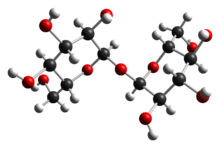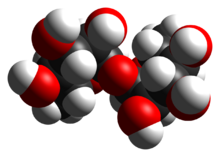Chemistry:Trehalose

| |

| |

| |
| Names | |
|---|---|
| IUPAC name
α-D-glucopyranosyl-(1→1)-α-D-glucopyranoside
| |
| Systematic IUPAC name
(2R,3S,4S,5R,6R)-2-(Hydroxymethyl)-6-[(2R,3R,4S,5S,6R)-3,4,
5-trihydroxy-6-(hydroxymethyl)oxan-2-yl]oxyoxane-3,4,5-triol | |
| Other names
α,α‐Trehalose
| |
| Identifiers | |
3D model (JSmol)
|
|
| ChEBI | |
| ChEMBL | |
| ChemSpider | |
PubChem CID
|
|
| UNII | |
| |
| |
| Properties | |
| C12H22O11 (anhydride) | |
| Molar mass | 342.296 g/mol (anhydrous) 378.33 g/mol (dihydrate) |
| Appearance | White orthorhombic crystals |
| Density | 1.58 g/cm3 at 24 °C |
| Melting point | 203 °C (397 °F; 476 K) (anhydrous) 97 °C (dihydrate) |
| 68.9 g per 100 g at 20 °C[1] | |
| Solubility | Slightly soluble in ethanol, insoluble in diethyl ether and benzene[2] |
Except where otherwise noted, data are given for materials in their standard state (at 25 °C [77 °F], 100 kPa). | |
| Infobox references | |
Trehalose (from Turkish tıgala – a sugar derived from insect cocoons + -ose)[3] is a sugar consisting of two molecules of glucose. It is also known as mycose or tremalose. Some bacteria, fungi, plants and invertebrate animals synthesize it as a source of energy, and to survive freezing and lack of water.
Extracting trehalose was once a difficult and costly process, but around 2000, the Hayashibara company (Okayama, Japan) discovered an inexpensive extraction technology from starch.[4][5] Trehalose has high water retention capabilities, and is used in food, cosmetics and as a drug. A procedure developed in 2017 using trehalose allows sperm storage at room temperatures.[6]
Structure
Trehalose is a disaccharide formed by a 1,1-glycosidic bond between two α-glucose units. It is found in nature as a disaccharide and also as a monomer in some polymers.[7] Two other isomers exist, α,β-trehalose, otherwise known as neotrehalose, and β,β-trehalose (also referred to as isotrehalose). Neotrehalose has not been isolated from a living organism. Isotrehalose is also yet to be isolated from a living organism, but was found in starch hydroisolates.[7]
Synthesis
At least three biological pathways support trehalose biosynthesis.[7] An industrial process can derive trehalose from corn starch.[8]
Properties
Chemical
Trehalose is a nonreducing sugar formed from two glucose units joined by a 1–1 alpha bond, giving it the name α-D-glucopyranosyl-(1→1)-α-D-glucopyranoside. The bonding makes trehalose very resistant to acid hydrolysis, and therefore is stable in solution at high temperatures, even under acidic conditions. The bonding keeps nonreducing sugars in closed-ring form, such that the aldehyde or ketone end groups do not bind to the lysine or arginine residues of proteins (a process called glycation). Trehalose is less soluble than sucrose, except at high temperatures (>80 °C). Trehalose forms a rhomboid crystal as the dihydrate, and has 90% of the calorific content of sucrose in that form. Anhydrous forms of trehalose readily regain moisture to form the dihydrate. Anhydrous forms of trehalose can show interesting physical properties when heat-treated.
Trehalose aqueous solutions show a concentration-dependent clustering tendency. Owing to their ability to form hydrogen bonds, they self-associate in water to form clusters of various sizes. All-atom molecular dynamics simulations showed that concentrations of 1.5–2.2 molar allow trehalose molecular clusters to percolate and form large and continuous aggregates.[9]
Trehalose directly interacts with nucleic acids, facilitates melting of double stranded DNA and stabilizes single-stranded nucleic acids.[10]
Biological
Organisms ranging from bacteria, yeast, fungi, insects, invertebrates, and lower and higher plants have enzymes that can make trehalose.[7] In nature, trehalose can be found in plants, and microorganisms. In animals, trehalose is prevalent in shrimp, and also in insects, including grasshoppers, locusts, butterflies, and bees, in which trehalose serves as blood-sugar.[citation needed] Trehalase genes are found in tardigrades, the microscopic ecdysozoans found worldwide in diverse extreme environments.[11]
Trehalose is the major carbohydrate energy storage molecule used by insects for flight.[citation needed] One possible reason for this is that the glycosidic linkage of trehalose, when acted upon by an insect trehalase, releases two molecules of glucose, which is required for the rapid energy requirements of flight. This is double the efficiency of glucose release from the storage polymer starch, for which cleavage of one glycosidic linkage releases only one glucose molecule.[citation needed]
In plants, trehalose is seen in sunflower seeds, moonwort, Selaginella plants,[12] and sea algae. Within the fungi, it is prevalent in some mushrooms, such as shiitake (Lentinula edodes), oyster, king oyster, and golden needle.[13]
Even within the plant kingdom, Selaginella (sometimes called the resurrection plant), which grows in desert and mountainous areas, may be cracked and dried out, but will turn green again and revive after rain because of the function of trehalose.[12]
The two prevalent theories as to how trehalose works within the organism in the state of cryptobiosis are the vitrification theory, a state that prevents ice formation, or the water displacement theory, whereby water is replaced by trehalose.[11][14]
In bacterial cell wall, trehalose has a structural role in adaptive responses to stress such as osmotic differences and extreme temperature.[15] Yeast uses trehalose as a carbon source in response to abiotic stresses.[16] In humans, the only known function of trehalose is its ability to activate autophagy inducer.[clarification needed]
Trehalose has also been reported for anti-bacterial, anti-biofilm, and anti-inflammatory (in vitro and in vivo) activities, upon its esterification with fatty acids of varying chain lengths.[17]
Nutritional and dietary properties
Trehalose is rapidly broken down into glucose by the enzyme trehalase, which is present in the brush border of the intestinal mucosa of omnivores (including humans) and herbivores.[18]:135 It causes less of a spike in blood sugar than glucose.[19] Trehalose has about 45% the sweetness of sucrose at concentrations above 22%, but when the concentration is reduced, its sweetness decreases more quickly than that of sucrose, so that a 2.3% solution tastes 6.5 times less sweet as the equivalent sugar solution.[20]:444
It is commonly used in prepared frozen foods, like ice cream, because it lowers the freezing point of foods.[19]
Deficiency of trehalase enzyme is unusual in humans, except in the Greenlandic Inuit, where it occurs in 10–15% of the population.[21]:197
Metabolism
Five biosynthesis pathways have been reported for trehalose. The most common pathway is TPS/TPP pathway which is used by organisms that synthesize trehalose using the enzyme trehalose-6-phosphate (T6P) synthase (TPS).[22] Second, trehalose synthase (TS) in certain types of bacteria could produce trehalose by using maltose and another disaccharide with two glucose units as substrates.[23] Third, the TreY-TreZ pathway in some bacteria converts starch that contain maltooligosaccharide or glycogen directly into trehalose.[24] Fourth, in primitive bacteria, trehalose glycisyltransferring synthase (TreT) produces trehalose from ADP-glucose and glucose.[25] Fifth, trehalose phosphorylase (TreP) either hydrolyses trehalose into glucose-1-phosphate and glucose or may act reversibly in certain species.[26] Vertebrates do not have the ability to synthesize or store trehalose.[27] Trehalase in humans is found only in specific location such as the intestinal mucosa, renal brush-border, liver and blood. Expression of this enzyme in vertebrates is initially found during the gestation period that is the highest after weaning. Then, the level of trehalase remained constant in the intestine throughout life.[28] Meanwhile, diets consisting of plants and fungi contain trehalose. Moderate amount of trehalose in diet is essential and having low amount of trehalose could result in diarrhea, or other intestinal symptoms.[29]
Medical use
Trehalose is an ingredient, along with hyaluronic acid, in an artificial tears product used to treat dry eye.[30][16] Outbreaks of Clostridium difficile were initially associated with trehalose,[19][31][32]. This finding was disputed in 2019.[33]
In 2021, the FDA accepted an Investigational New Drug (IND) application and granted granted fast track status for an injectable form of trehalose (SLS-005) as a potential treatment for spinocerebellar ataxia type 3 (SCA3).[34][35]
History
In 1832, H.A.L. Wiggers discovered trehalose in an ergot of rye,[36] and in 1859 Marcellin Berthelot isolated it from Trehala manna, a substance made by weevils and named it trehalose.[37]
Trehalose has long been known as an autophagy inducer that acts independently of mTOR.[38] In 2017, research was published showing that trehalose induces autophagy by activating TFEB,[39] a protein that acts as a master regulator of the autophagy-lysosome pathway.[40]
See also
References
- ↑ Higashiyama, Takanobu (2002). "Novel functions and applications of trehalose". Pure Appl. Chem. 74 (7): 1263–1269. doi:10.1351/pac200274071263. http://www.iupac.org/publications/pac/2002/pdf/7407x1263.pdf.
- ↑ Lide, David R. (1998). Handbook of Chemistry and Physics (87 ed.). Boca Raton, Florida: CRC Press. pp. 3–534. ISBN 978-0-8493-0594-8.
- ↑ "Trehalose | Definition of Trehalose by Lexico". https://www.lexico.com/en/definition/trehalose.
- ↑ Cargill, Incorporated (30 May 2011). "Cargill, Hayashibara to Introduce Trehalose Sweetener to the Americas". PR Newswire. http://www.prnewswire.com/news-releases/cargill-hayashibara-to-introduce-trehalose-sweetener-to-the-americas-73349167.html.
- ↑ "JAPAN: Cargill, Hayashibara to Introduce Trehalose Sweetener to the Americas". just-food.com. 2000-05-31. http://www.just-food.com/news/cargill-hayashibara-to-introduce-trehalose-sweetener-to-the-americas_id90417.aspx.
- ↑ Patrick, Jennifer L.; Elliott, Gloria D.; Comizzoli, Pierre (1 November 2017). "Structural integrity and developmental potential of spermatozoa following microwave-assisted drying in the domestic cat model". Theriogenology 103: 36–43. doi:10.1016/j.theriogenology.2017.07.037. PMID 28772113.
- ↑ 7.0 7.1 7.2 7.3 "New insights on trehalose: a multifunctional molecule". Glycobiology 13 (4): 17R–27R. April 2003. doi:10.1093/glycob/cwg047. PMID 12626396.
- ↑ [|permanent dead link|dead link}}] GRAS Notification for Hayashibara Trehalose. Food and Drug Administration. May 3, 2000. p. 10. http://www.accessdata.fda.gov/scripts/fcn/gras_notices/214653a.pdf.
- ↑ "Linking trehalose self-association with binary aqueous solution equation of state". The Journal of Physical Chemistry B 115 (4): 624–34. February 2011. doi:10.1021/jp109780n. PMID 21186829.
- ↑ "Trehalose facilitates DNA melting: a single-molecule optical tweezers study". Soft Matter 10 (37): 7269–77. October 2014. doi:10.1039/C4SM01532K. PMID 25096217. Bibcode: 2014SMat...10.7269B.
- ↑ 11.0 11.1 Kamilari, Maria; Jørgensen, Aslak; Schiøtt, Morten; Møbjerg, Nadja (2019-07-24). "Comparative transcriptomics suggest unique molecular adaptations within tardigrade lineages". BMC Genomics 20 (1): 607. doi:10.1186/s12864-019-5912-x. ISSN 1471-2164. PMID 31340759.
- ↑ 12.0 12.1 "A Selaginella lepidophylla trehalose-6-phosphate synthase complements growth and stress-tolerance defects in a yeast tps1 mutant". Plant Physiology 119 (4): 1473–82. April 1999. doi:10.1104/pp.119.4.1473. PMID 10198107.
- ↑ "Chemical composition and nutritional value of the most widely appreciated cultivated mushrooms: an inter-species comparative study". Food and Chemical Toxicology 50 (2): 191–7. February 2012. doi:10.1016/j.fct.2011.10.056. PMID 22056333. https://bibliotecadigital.ipb.pt/bitstream/10198/7341/5/Reis_et_al_FCT_revised_2.pdf.
- ↑ "Stabilization against thermal inactivation promoted by sugars on enzyme structure and function: why is trehalose more effective than other sugars?". Archives of Biochemistry and Biophysics 360 (1): 10–4. December 1998. doi:10.1006/abbi.1998.0906. PMID 9826423.
- ↑ Iturriaga, Gabriel; Suárez, Ramón; Nova-Franco, Barbara (2009). "Trehalose Metabolism: From Osmoprotection to Signaling" (in en). International Journal of Molecular Sciences 10 (9): 3793–3810. doi:10.3390/ijms10093793. PMID 19865519.
- ↑ 16.0 16.1 "Over the counter (OTC) artificial tear drops for dry eye syndrome". The Cochrane Database of Systematic Reviews 2016 (2): CD009729. February 2016. doi:10.1002/14651858.CD009729.pub2. PMID 26905373.
- ↑ Marathe, Sandesh J.; Shah, Nirali N.; Singhal, Rekha S. (2020-01-01). "Enzymatic synthesis of fatty acid esters of trehalose: Process optimization, characterization of the esters and evaluation of their bioactivities" (in en). Bioorganic Chemistry 94: 103460. doi:10.1016/j.bioorg.2019.103460. ISSN 0045-2068. PMID 31791682. https://www.sciencedirect.com/science/article/pii/S0045206819311368.
- ↑ Mathlouthi, M., ed (1999). Food packaging and preservation. Gaithersburg, Md.: Aspen Publishers. ISBN 978-0-8342-1349-4. https://books.google.com/books?id=gNkTBKZrcloC&q=trehalose+dietary+brush+border&pg=PA135. Retrieved 25 June 2014.
- ↑ 19.0 19.1 19.2 Collins, Francis (9 January 2018). "Has an Alternative to Table Sugar Contributed to the C. Diff. Epidemic?". NIH Director's Blog. https://directorsblog.nih.gov/2018/01/09/has-a-sucrose-alternative-contributed-to-the-c-diff-epidemic/.
- ↑ O'Brien-Nabors, Lyn, ed (2012). Alternative sweeteners (4th ed.). Boca Raton: CRC Press. ISBN 978-1-4398-4614-8. https://books.google.com/books?id=coDPwzFX7rAC&pg=PA444. Retrieved 25 June 2014.
- ↑ Kohlmeier, Martin (2003). Nutrient Metabolism. Burlington: Elsevier. ISBN 978-0-08-053789-4. https://books.google.com/books?id=sAwqrHtcyM8C&q=trehalose+dietary&pg=PA197. Retrieved 25 June 2014.
- ↑ Cabib, E.; Leloir, L. F. (1958). "The biosynthesis of trehalose phosphate". The Journal of Biological Chemistry 231 (1): 259–275. doi:10.1016/S0021-9258(19)77303-7. ISSN 0021-9258. PMID 13538966.
- ↑ Nishimoto, T.; Nakano, M.; Nakada, T.; Chaen, H.; Fukuda, S.; Sugimoto, T.; Kurimoto, M.; Tsujisaka, Y. (April 1996). "Purification and properties of a novel enzyme, trehalose synthase, from Pimelobacter sp. R48". Bioscience, Biotechnology, and Biochemistry 60 (4): 640–644. doi:10.1271/bbb.60.640. ISSN 0916-8451. PMID 8829531.
- ↑ Maruta, Kazuhiko; Mitsuzumi, Hitoshi; Nakada, Tetsuya; Kubota, Michio; Chaen, Hiroto; Fukuda, Shigeharu; Sugimoto, Toshiyuki; Kurimoto, Masashi (1996-12-06). "Cloning and sequencing of a cluster of genes encoding novel enzymes of trehalose biosynthesis from thermophilic archaebacterium Sulfolobus acidocaldarius" (in en). Biochimica et Biophysica Acta (BBA) - General Subjects 1291 (3): 177–181. doi:10.1016/S0304-4165(96)00082-7. ISSN 0304-4165. PMID 8980629. https://www.sciencedirect.com/science/article/pii/S0304416596000827.
- ↑ Qu, Qiuhao; Lee, Sung-Jae; Boos, Winfried (2004-11-12). "TreT, a Novel Trehalose Glycosyltransferring Synthase of the Hyperthermophilic Archaeon Thermococcus litoralis*" (in English). Journal of Biological Chemistry 279 (46): 47890–47897. doi:10.1074/jbc.M404955200. ISSN 0021-9258. PMID 15364950. https://www.jbc.org/article/S0021-9258(20)67926-1/abstract.
- ↑ Ren, Yuanyuan; Dai, Xiuyu; Zhou, Jian; Liu, Jingfang; Pei, Huadong; Xiang, Hua (2005-05-01). "Gene expression and molecular characterization of a thermostable trehalose phosphorylase fromThermoanaerobacter tengcongensis" (in en). Science in China Series C: Life Sciences 48 (3): 221–227. doi:10.1007/BF03183615. ISSN 1862-2798. PMID 16092754. https://doi.org/10.1007/BF03183615.
- ↑ Elbein, Alan D. (1974-01-01), Tipson, R. Stuart; Horton, Derek, eds., "The Metabolism of α,α-Trehalose**The work cited from the author's laboratory was supported by grants from the Robert A. Welch Foundation and the National Institutes of Health (AI 09402)." (in en), Advances in Carbohydrate Chemistry and Biochemistry (Academic Press) 30: 227–256, doi:10.1016/S0065-2318(08)60266-8, PMID 4377836, https://www.sciencedirect.com/science/article/pii/S0065231808602668, retrieved 2021-11-30
- ↑ Galand, G. (1989). "Brush border membrane sucrase-isomaltase, maltase-glucoamylase and trehalase in mammals. Comparative development, effects of glucocorticoids, molecular mechanisms, and phylogenetic implications". Comparative Biochemistry and Physiology. B, Comparative Biochemistry 94 (1): 1–11. doi:10.1016/0305-0491(89)90002-3. ISSN 0305-0491. PMID 2513162. https://pubmed.ncbi.nlm.nih.gov/2513162/.
- ↑ Thevelein, J M (March 1984). "Regulation of trehalose mobilization in fungi.". Microbiological Reviews 48 (1): 42–59. doi:10.1128/mr.48.1.42-59.1984. ISSN 0146-0749. PMID 6325857.
- ↑ "A randomized crossover study comparing trehalose/hyaluronate eyedrops and standard treatment: patient satisfaction in the treatment of dry eye syndrome". Therapeutics and Clinical Risk Management 11: 595–603. 2015. doi:10.2147/TCRM.S77091. PMID 25926736.
- ↑ "Pathogens boosted by food additive". Nature 553 (7688): 285–286. January 2018. doi:10.1038/d41586-017-08775-4. PMID 29345660.
- ↑ "Dietary trehalose enhances virulence of epidemic Clostridium difficile". Nature 553 (7688): 291–294. January 2018. doi:10.1038/nature25178. PMID 29310122. Bibcode: 2018Natur.553..291C.
- ↑ Eyre, David W.; Didelot, Xavier; Buckley, Anthony M.; Freeman, Jane; Moura, Ines B.; Crook, Derrick W.; Peto, Tim E.A.; Walker, A. Sarah et al. (2019). "Clostridium difficile trehalose metabolism variants are common and not associated with adverse patient outcomes when variably present in the same lineage". eBioMedicine 43: 347–355. doi:10.1016/j.ebiom.2019.04.038. ISSN 2352-3964. PMID 31036529.
- ↑ Park, Brian (8 November 2021). "Trehalose Fast Tracked for Spinocerebellar Ataxia". https://www.empr.com/home/news/drugs-in-the-pipeline/trehalose-fast-tracked-for-spinocerebellar-ataxia/.
- ↑ "FDA Accepts Investigational New Drug Application and Grants Fast Track Designation of Trehalose for Spinocerebellar Ataxia Treatment". 12 November 2021. https://practicalneurology.com/news/fda-accepts-investigational-new-drug-application-and-grants-fast-track-designation-of-trehalose-for-spinocerebellar-ataxia-treatment.
- ↑ "Untersuchung über das Mutterkorn, Secale cornutum". Annalen der Pharmacie 1 (2): 129–182. 1832. doi:10.1002/jlac.18320010202. https://zenodo.org/record/1426894.
- ↑ "Le Tréhala, une drogue à la croisée des chemins" (in fr). Revue d'Histoire de la Pharmacie 57 (362): 163–72. July 2009. doi:10.3406/pharm.2009.22043. PMID 20027793.
- ↑ "Compromised autophagy and neurodegenerative diseases". Nature Reviews. Neuroscience 16 (6): 345–57. June 2015. doi:10.1038/nrn3961. PMID 25991442.
- ↑ "Lysosomes and Brain Health". Annual Review of Neuroscience 41: 255–276. July 2018. doi:10.1146/annurev-neuro-080317-061804. PMID 29661037.
- ↑ "Transcription factor EB: from master coordinator of lysosomal pathways to candidate therapeutic target in degenerative storage diseases". Annals of the New York Academy of Sciences 1371 (1): 3–14. May 2016. doi:10.1111/nyas.13131. PMID 27299292. Bibcode: 2016NYASA1371....3S.
External links
 |

